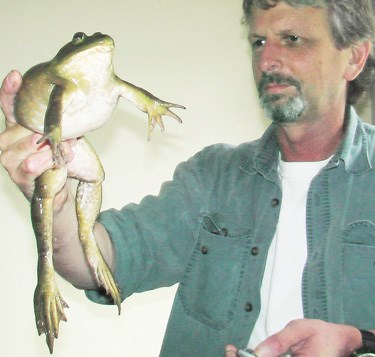The Capital Regional District is losing its battle with the American bullfrog but some directors are unsure whether to step up the fight or throw in the towel.
The CRD has been waging war with the American bullfrog since 2006 — spending thousands of dollars on an eradication program to try to stop the invasive amphibian's’ march from the Saanich Peninsula westward toward the Sooke watershed, Greater Victoria’s main source of drinking water.
And even though an estimated 30,000 adult and juvenile bullfrogs have been captured and killed since the program began seven years ago, CRD staff say the bullfrog numbers keep growing.
The measures are effective, Mike Walton, senior manager CRD parks, told members of the regional parks committee Wednesday. “However, the key issue that I can discern is that the reproduction rates are greater than what we are able to manage through the control program.”
The CRD is budgeted to spend about $74,000 — split between CRD water and CRD parks — on the bullfrog eradication program this year. That money has been augmented over the years by contributions from municipalities such as Saanich, Langford and Metchosin.
To keep on top of the problem, the program budget would likely have to be increased this year, said Larisa Hutcheson, general manager of parks and environmental services. And, she said, funding probably should be included as part of the CRD’s core budget rather than continually being included as a supplemental budget item.
“It’s a management program that we’re going to have to accept as something that we’re going to need to be doing for the foreseeable future to stay on top of it,” she said.
The species is thought to have first shown up in Elk and Beaver lakes in the late 1980s, introduced by a child emptying a bucket of tadpoles collected on the Lower Mainland and by a couple of frog farmers.
The American bullfrog has been billed as a voracious, alien invader that could seriously disrupt the health of the Greater Victoria’s drinking water reservoirs by devouring native fauna. Once adult, bullfrogs can grow to the size of a dinner plate and will eat turtles, baby ducks, woodland birds and garter snakes. Bullfrogs could also infest the environment with new bacteria or parasites.
But CRD chairman Alastair Bryson said he had concerns about attempts to manage nature and wondered whether directors were getting the full picture about the threat the frogs pose and the need for the management program.
Bryson said there’s a large resident population of the American bullfrogs in irrigation ponds on the Saanich Peninsula — and that’s not necessarily a bad thing. “If there was actually a sense or a value in eradicating them, then I think we need to make that business case. But at this point, they may be even doing a significant amount of Canada goose management, quite frankly, by eating goslings.”
Highlands Mayor Jane Mendum said she supported the eradication program.
“CRD parks does not want to be the one that has an overload of bullfrogs that are actually going out onto private property lands or other types of property. So it’s really important we do have a management plan,” Mendum said. “To not do our part to try to keep the numbers in check in the waterways that are in our parks would probably be fairly irresponsible at this point.”
CRD staff are to report back on the program.



